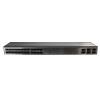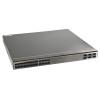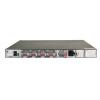-
€



Huawei S6730-S24X6Q es un switch eficiente de la serie CloudEngine. Está equipado con 24 ranuras SFP+ con un ancho de banda de 10 Gb/s cada una y 6 ranuras QSFP+ con un ancho de banda de 40 Gb/s. El conjunto incluye un adaptador de CA con un rango de voltaje de 100 - 240 V (600 W, máx. 8 A). El switch puede ser utilizado con éxito por operadores de Internet, en campus escolares o en varios tipos de instituciones.
El producto ofrecido es compatible con multidifusión avanzada, incluidos PIM-SM, PIM-DM, PIM-SSM y Multicast VPN. También cuenta con amplias funciones de Layer 3 como RIP v1/2, OSPF, OSPFv3, IS-IS, IS-ISv6, BGP y BGP4+. Una ventaja adicional son las numerosas medidas de seguridad, detecta el tráfico no estándar y potencialmente peligroso, analiza las amenazas en el tráfico cifrado (Encrypted Communication Analytics) y puede cooperar con el Sistema de inteligencia de seguridad cibernética (CIS) de Huawei.
Una ventaja adicional es la posibilidad de apilamiento virtual de varios switchs mediante iStack. El dispositivo es compatible con la virtualización basada en VXLAN, le permite conectarse a redes inalámbricas y cableadas. Puede manejar hasta 1024 puntos de acceso en una red, actúa como su controlador (incluida la administración de dominios o las plantillas de configuración).
Las caracteristicas mas importantes
- 24 ranuras SFP+;
- 6 ranuras QSFP+ (40 Gb/s);
- posibilidad de conectar redes alambricas e inalambricas
- soporte VXLAN;
- numerosas caracteristicas de seguridad
Especificación:
| S6730-S24X6C | |
| Puertos |
24 ranuras SFP+ 10 Gb/s 6 ranuras QSFP+ 40 Gb/s |
| Dimensiones | 442 x 420 x 43,6 mm |
| Altura | 1 U |
|
Entrada de alimentación |
Rango de voltaje sugerido: 100 - 240 V AC (50 / 60 Hz) Rango de voltaje máximo: 90 - 290 V AC (45 - 65 Hz) |
|
Potencia de entrada / corriente |
600 W máx. 8 A |
|
Consumo máximo de energía |
225 W |
|
Consumo mínimo de energía |
88 W |
|
Temperatura de almacenamiento admisible |
De -40 a 70 ºC |
| Volumen | 52 dB |
|
Protección contra sobretensiones |
±6kV |
|
Humedad del aire admisible |
5%-95%
sin condensación |
| Enfriamiento | Activo, 4
ventiladores desmontables |
| Właściwości oprogramowania | |
|---|---|
| MAC |
Up to 64K MAC address entries |
| VLAN |
4K VLANs |
| ARP |
Static ARP |
| Routing IP |
Static routes, RIP v1/2, RIPng, OSPF, OSPFv3, IS-IS, IS-ISv6, BGP, BGP4+, ECMP, routing |
| interoperabilidad |
VLAN-Based Spanning Tree (VBST), working with PVST, PVST+, and RPVST |
|
Protección contra bucles Ethernet |
RRPP ring topology and RRPP multi-instance Smart Link tree topology and Smart Link multi-instance, providing millisecond-level protection |
|
Propiedades IPv6 |
Neighbor Discover (ND) |
| Multicast |
IGMP v1/v2/v3 snooping and IGMP fast leave |
| QoS/ACL |
Rate limiting in the inbound and outbound directions of a port |
| Seguridad |
Hierarchical user management and password protection HTTPS |
| Otros |
LACP |
| VXLAN |
VXLAN functions, VXLAN L2 and L3 gateways, BGP EVPN |
| SVF |
Acting as the parent node to vertically virtualize downlink switches and APs as one device for |
| iPCA | Marking service packets to obtain the packet loss ratio and number of lost packets in real time Measurement of the number of lost packets and packet loss ratio on networks and devices |
|
Gestión y seguimiento |
Cloud-based management |






 Polski
Polski English
English Italiano
Italiano Español
Español Čeština
Čeština Српски
Српски Deutsch
Deutsch Ελληνικά
Ελληνικά Slovenský
Slovenský




